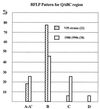Evidence for extensive resistance gene transfer among Bacteroides spp. and among Bacteroides and other genera in the human colon
- PMID: 11157217
- PMCID: PMC92621
- DOI: 10.1128/AEM.67.2.561-568.2001
Evidence for extensive resistance gene transfer among Bacteroides spp. and among Bacteroides and other genera in the human colon
Abstract
Transfer of antibiotic resistance genes by conjugation is thought to play an important role in the spread of resistance. Yet virtually no information is available about the extent to which such horizontal transfers occur in natural settings. In this paper, we show that conjugal gene transfer has made a major contribution to increased antibiotic resistance in Bacteroides species, a numerically predominant group of human colonic bacteria. Over the past 3 decades, carriage of the tetracycline resistance gene, tetQ, has increased from about 30% to more than 80% of strains. Alleles of tetQ in different Bacteroides species, with one exception, were 96 to 100% identical at the DNA sequence level, as expected if horizontal gene transfer was responsible for their spread. Southern blot analyses showed further that transfer of tetQ was mediated by a conjugative transposon (CTn) of the CTnDOT type. Carriage of two erythromycin resistance genes, ermF and ermG, rose from <2 to 23% and accounted for about 70% of the total erythromycin resistances observed. Carriage of tetQ and the erm genes was the same in isolates taken from healthy people with no recent history of antibiotic use as in isolates obtained from patients with Bacteroides infections. This finding indicates that resistance transfer is occurring in the community and not just in clinical environments. The high percentage of strains that are carrying these resistance genes in people who are not taking antibiotics is consistent with the hypothesis that once acquired, these resistance genes are stably maintained in the absence of antibiotic selection. Six recently isolated strains carried ermB genes. Two were identical to erm(B)-P from Clostridium perfringens, and the other four had only one to three mismatches. The nine strains with ermG genes had DNA sequences that were more than 99% identical to the ermG of Bacillus sphaericus. Evidently, there is a genetic conduit open between gram-positive bacteria, including bacteria that only pass through the human colon, and the gram-negative Bacteroides species. Our results support the hypothesis that extensive gene transfer occurs among bacteria in the human colon, both within the genus Bacteroides and among Bacteroides species and gram-positive bacteria.
Figures



References
-
- Butler E, Joiner K A, Malamy M, Barlett J C, Tally F P. Transfer of tetracycline or clindamycin resistance among strains of Bacteroides fragilis in experimental abscesses. J Infect Dis. 1984;150:20–24. - PubMed
Publication types
MeSH terms
Substances
Grants and funding
LinkOut - more resources
Full Text Sources
Other Literature Sources
Miscellaneous

